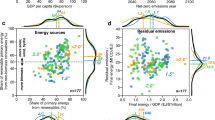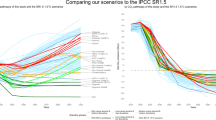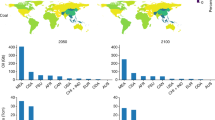Abstract
The size of the global bioenergy resource has been studied extensively; however, the corresponding life-cycle greenhouse gas benefit of bioenergy remains largely unexplored at the global scale. Here we quantify the optimal use of global bioenergy resources to offset fossil fuels in 2050. We find that bioenergy could reduce life-cycle emissions from fossil fuel-derived electricity and heat, and liquid fuels, by a maximum of 4.9–38.7 Gt CO2e, or 9–68%, and that offsetting electricity and heat with bioenergy is on average 1.6–3.9 times more effective for emissions mitigation than offsetting liquid fuels. At the same time, liquid fuels make up 18–49% of the optimal allocation of bioenergy in our results for 2050, indicating that a mix of bioenergy end-uses maximizes life-cycle emissions reductions. Finally, emissions reductions are maximized by limiting deployment of total available primary bioenergy to 29–91% in our analysis, demonstrating that life-cycle emissions are a constraint on the usefulness of bioenergy for mitigating global climate change.
This is a preview of subscription content, access via your institution
Access options
Access Nature and 54 other Nature Portfolio journals
Get Nature+, our best-value online-access subscription
$29.99 / 30 days
cancel any time
Subscribe to this journal
Receive 12 digital issues and online access to articles
$119.00 per year
only $9.92 per issue
Buy this article
- Purchase on Springer Link
- Instant access to full article PDF
Prices may be subject to local taxes which are calculated during checkout



Similar content being viewed by others
References
About the Bioenergy Technologies Office: Growing America’s Energy Future (US DOE BETO, 2015); http://energy.gov/eere/bioenergy/about-bioenergy-technologies-office-growing-americas-energy-future
State of Play on the Sustainability of Solid and Gaseous Biomass Used for Electricity, Heating and Cooling in the EU (European Commission, 2014); https://ec.europa.eu/energy/en/topics/renewable-energy/biomass
IPCC Task Force on National Greenhouse Gas Inventories (TFI), General Guidance and Other Inventory Issues (IPCC, accessed 6 January 2016); http://www.ipcc-nggip.iges.or.jp/faq/faq.html
Wang, M., Wu, M. & Huo, H. Life-cycle energy and greenhouse gas emission impacts of different corn ethanol plan types. Environ. Res. Lett. 2, 024001 (2007).
Huo, H., Wang, M., Bloyd, C. & Putsche, V. Life-cycle assessment of energy use and greenhouse gas emissions of soybean-derived biodiesel and renewable fuels. Environ. Sci. Technol. 43, 750–756 (2009).
Farrell, A. E. et al. Ethanol can contribute to energy and environmental goals. Science 311, 506–508 (2006).
Stratton, R. W., Wong, H. M. & Hileman, J. I. Quantifying variability in life cycle greenhouse gas inventories of alternative middle distillate transportation fuels. Environ. Sci. Technol. 45, 4637–4644 (2011).
Wang, M., Han, J., Cai, H. & Elgowainy, A. Well-to-wheels energy use and greenhouse gas emissions of ethanol from corn, sugarcane and cellulosic biomass for US use. Environ. Res. Lett. 7, 045905 (2012).
Staples, M. D. et al. Lifecycle greenhouse gas footprint and minimum selling price of renewable diesel and jet fuel from fermentation and advanced fermentation production technologies. Energy Environ. Sci. 7, 1545–1554 (2014).
Edwards, R. et al. JEC Well-to-Wheels Analysis: Well-to-Wheels Analysis of Future Automotive Fuels and Powertrains in the European Context (European Commission Joint Research Centre, 2014); http://iet.jrc.ec.europa.eu/about-jec/sites/iet.jrc.ec.europa.eu.about-jec/files/documents/wtw_report_v4a_march_2014_final_333_rev_140408.pdf
Elgowainy, A. et al. Well-to-Wheels Analysis of Energy Use and Greenhouse Gas Emissions of Plug-in Hybrid Electric Vehicles (Argonne National Laboratory, accessed 3 September 2015); http://www.transportation.anl.gov/pdfs/TA/629.pdf
Burnham, A. et al. Life-cycle greenhouse gas emissions of shale gas, natural gas, coal and petroleum. Environ. Sci. Technol. 46, 619–627 (2012).
Searchinger, T. et al. Use of US croplands for biofuels increases greenhouse gases through emissions from land-use change. Science 319, 1238–1240 (2008).
Hertel, T. W. et al. Effects of US maize ethanol on global land use and greenhouse gas emissions: estimating market-mediated responses. BioScience 60, 223–231 (2010).
Plevin, R. J. et al. Greenhouse gas emissions from biofuels’ indirect land use change are uncertain but may be much greater than previously estimated. Environ. Sci. Technol. 44, 8015–8021 (2010).
Fischer, G. & Schrattenholzer, L. Global bioenergy potentials through 2050. Biomass Bioenergy 20, 151–159 (2001).
Hoogwijk, M., Faaij, A., Eickhout, B., de Vries, B. & Turkenburg, W. Potential of biomass energy out to 2100, for four IPCC SRES land-use scenarios. Biomass Bioenergy 29, 225–257 (2005).
Field, C. B., Campbell, J. E. & Lobell, D. B. Biomass energy: the scale of the potential resource. Trends Ecol. Evolut. 23, 65–72 (2008).
Ros, J., Olivier, J., Notenboom, J., Croezen, H. & Bergsma, G. Sustainability of Biomass in a Bio-Based Economy (PBL Netherlands Environmental Assessment Agency, 2012); http://www.pbl.nl/sites/default/files/cms/publicaties/PBL-2012-Sustainability-of-biomass-in-a-BBE-500143001_0.pdf
Searle, S. & Malins, C. A reassessment of global bioenergy potential in 2050. GCB Bioenergy 7, 328–336 (2015).
Slade, R., Bauen, A. & Gross, R. Global bioenergy resources. Nat. Clim. Change 4, 99–105 (2014).
Energy Technology Perspectives 2014 (OECD, IEA, accessed 3 September 2015); http://www.iea.org/etp/etp2014
Global Arable Land Area and Area Harvested (FAOSTAT, accessed 11 October 2016); http://fenix.fao.org/faostat/beta/en/#data/RL
Daioglou, V., Stehfest, E., Wicke, B., Faaij, A. & van Vuuren, D. P. Projections of the availability and cost of residues from agriculture and forestry. Glob. Change Biol. Bioenergy 8, 456–470 (2015).
IEA CO2 Emissions from Fuel Combustion: Highlights (OECD, IEA, 2015); http://www.iea.org/publications/freepublications/publication/CO2EmissionsFromFuelCombustionHighlights2015.pdf
Trivedi, P., Malina, R. & Barrett, S. R. H. Environmental and economic tradeoffs of using corn stover for liquid fuels and power production. Energy Environ. Sci. 8, 1428–1437 (2015).
Steubing, B., Zah, R. & Ludwig, C. Heat, electricity or transportation? The optimal use of residual and waste biomass in Europe from and environmental perspective. Environ. Sci. Technol. 46, 164–171 (2012).
Campbell, J. E., Lobell, D. B. & Field, C. B. Greater transportation energy and GHG offsets from bioelectricity than ethanol. Science 324, 1055–1057 (2009).
Technology Roadmap: Bioenergy for Heat and Power (OECD, IEA, accessed 3 September 2015); http://www.iea.org/publications/freepublications/publication/technology-roadmap-bioenergy-for-heat-and-power-.html
Maximising the Environmental Benefits of Europe’s Bioenergy Potential (EEA, 2008); http://www.eea.europa.eu/publications/technical_report_2008_10
Dray, L., Evans, A., Reynolds, T. & Schaefer, A. Mitigation of aviation emissions of carbon dioxide. Transp. Res. Rec. 2177, 17–26 (2010).
Hileman, J., De la Rosa Blanco, E., Bonnefoy, P. A. & Carter, N. A. The carbon dioxide challenge facing aviation. Prog. Aerosp. Sci. 63, 84–95 (2013).
Sgouridis, S., Bonnefoy, P. A. & Hansman, R. J. Air transportation in a carbon constrained world: long-term dynamics of policies and strategies for mitigating the carbon footprint of commercial aviation. Transp. Res. A 45, 1077–1091 (2011).
Lal, R. Carbon sequestration. Phil. Trans. R. Soc. B 363, 815–830 (2008).
Hileman, J. I. et al. Near-Term Feasibility of Alternative Jet Fuels (RAND Corporation, 2009); http://www.rand.org/pubs/technical_reports/TR554.html
Bond, J. Q. et al. Production of renewable jet fuel range alkanes and commodity chemicals from integrated catalytic processing of biomass. Energy Environ. Sci. 7, 1500–1523 (2014).
Cox, K., Renouf, M., Dargan, A., Turner, C. & Klein-Marcuschamer, D. Environmental life cycle assessment (LCA) of aviation biofuels from microalgae, Pongamia pinnata, and sugarcane molasses. Biofuel Bioprod. Bior. 8, 579–593 (2014).
Fan, J., Shonnard, D. R., Kalnes, T. N., Johnsen, P. B. & Rao, S. A life cycle assessment of pennycress (Thlaspi arvense L.)–derived jet fuel and diesel. Biomass Bioenergy 55, 87–100 (2013).
Seber, G., Malina, R., Pearlson, M. N., Olcay, H., Hileman, J. I. & Barrett, S. R. H. Environmental and economic assessment of producing hydroprocessed jet and diesel fuel from waste oils and tallow. Biomass Bioenergy 67, 108–118 (2014).
Shonnard, D. R., Williams, L. & Kalnes, T. B. Camelina-derived jet fuel and diesel: sustainable advanced biofuels. Environ. Prog. Sustain. Energy 29, 382–392 (2010).
Pearlson, M. N., Wollersheim, C. W. & Hileman, J. I. A techno-economic review of hydroprocessed renewable esters and fatty acids for jet fuel production. Biofuel Bioprod. Bior. 7, 89–96 (2013).
Regulation of Fuels and Fuel Additives: Changes to Renewable Fuel Standard Program; Final Rule Federal Register 40 CFR Part 80, 14669–15320 (US EPA, 2010).
Directive 2009/28/EC of the European Parliament and of the Council of 23 April 2009 on the Promotion of the Use of Energy from Renewable Sources and Amending and Subsequently Repealing Directives 2001/77/EC and 2003/30/EC Document 32009L0028, Procedure2008/0016/COD (EU EC, 2009).
Langeveld, J. W. A., Dixon, J., van Keulen, H. & Quist-Wessel, P. M. F. Analyzing the effect of biofuel expansion on land use in major producing countries: evidence of increased multiple cropping. Biofuel Bioprod. Bior. 8, 49–58 (2014).
Wigmosta, M. K., Coleman, A. M., Skaggs, R. J., Huesemass, M. H. & Lane, L. J. National microalgae biofuel production potential and resource demand. Wat. Resour. Res. 47, W00H04 (2011).
Rose, S. K. et al. Bioenergy in energy transformation and climate management. Climatic Change 123, 477–493 (2014).
Humpenoeder, F. et al. Investigating afforestation and bioenergy CCS as climate change mitigation strategies. Environ. Res. Lett. 9, 064029 (2014).
Azar, C., Johansson, D. J. A. & Mattsson, N. Meeting global temperature targets—the role of bioenergy with carbon capture and storage. Environ. Res. Lett. 8, 1–8 (2013).
Myhre, G. et al. in Climate Change 2013: The Physical Science Basis (eds Stocker, T. F. et al.) 659–740 (IPCC, Cambridge Univ. Press, 2013).
Database of Historical Areal Crop Yields (FAOSTAT, accessed 20 August 2016); http://faostat3.fao.org/home/E
Global Agro-Ecological Zones (GAEZ) Model (IIASA, accessed 20 August 2016); http://www.gaez.iiasa.ac.at
Land Use Harmonization Project of Future Land Use Projections (Univ. Maryland, accessed 20 August 2016); http://luh.umd.edu
Gibbs, H., Yui, S. & Plevin, R. New Estimates of Soil and Biomass Carbon Stocks for Global Economic Models (GTAP Technical Paper No. 33, Purdue University, 2014); https://www.gtap.agecon.purdue.edu/resources/download/6688.pdf
SSP Database (IIASA, accessed 20 August 2016); https://tntcat.iiasa.ac.at/SspDb/dsd?Action=htmlpage&page=about
Lal, R. World crop residues production and implications of its use as a biofuel. Environ. Int. 31, 575–584 (2005).
Andrews, S. S. Crop Residue Removal for Biomass Energy production: Effects on Soils and Recommendations (United States Department of Agriculture – Natural Resource Conservation Service, 2006); http://www.nrcs.usda.gov/Internet/FSE_DOCUMENTS/nrcs142p2_053255.pdf
Pratt, M. R. et al. Synergies between cover crops and corn stover removal. Agric. Syst. 130, 67–76 (2014).
Searle, S. & Malins, C. Will energy crop yields meet expectations? Biomass Bioenergy 65, 3–12 (2014).
Smeets, E. M. W. & Faaij, A. P. C. Bioenergy potentials from forestry in 2050. Climatic Change 81, 353–390 (2007).
McKeever, D. B. Inventories of Woody Residues and Solid Wood Waste in the United States (United States Department Agriculture – Forest Service, Forest Product Laboratory, 2002); http://originwww.fpl.fs.fed.us/documnts/pdf2004/fpl_2004_mckeever002.pdf
Alexandratos, N. & Bruinsma, J. World Agriculture Towards 2030/2050: The 2012 Revision (United Nations Food and Agricultural Agency, 2012); http://www.fao.org/docrep/016/ap106e/ap106e.pdf
Jayathilakan, K. et al. Utilization of byproducts and waste materials from meat, poultry and fish processing industries: a review. J. Food Sci. Technol. 49, 278–293 (2012).
Lopez, D. E., Mullins, J. C. & Bruce, D. A. Energy life cycle assessment for the production of biodiesel from rendered lipids in the United States. Ind. Eng. Chem. Res. 49, 2419–2432 (2010).
Niederl, A. & Narodoslawsky, M. in Feedstocks for the Future (eds Bozell, J. J. & Patel, M. K. ) 239–252 (American Chemical Society, 2006).
The Greenhouse Gases, Regulated Emissions, Energy Use in Transportation Model (Argonne National Laboratory, 2015); https://greet.es.anl.gov/greet_1_series
World Energy Outlook 2014 (OECD, IEA, 2014).
Acknowledgements
Financial support for this work was provided in part by the Natural Sciences and Engineering Research Council of Canada (NSERC), application number PGSD3-454375-2014, and in part by the Martin Family Society of Fellows for Sustainability. Any opinions, findings and conclusions or recommendations expressed in this material are those of the authors and do not necessarily reflect the views of NSERC or the Martin Family Society. The authors wish to acknowledge W. Tyner of Purdue University for his assistance with the GTAP AEZ-EF database, and J. Hileman and D. Williams of the US Federal Aviation Administration for their comments on this work.
Author information
Authors and Affiliations
Contributions
All three authors contributed equally to the conception and design of this work, interpretation of the results, and editing of the text. M.D.S. performed the analysis and drafted the manuscript.
Corresponding author
Ethics declarations
Competing interests
The authors declare no competing financial interests.
Supplementary information
Supplementary Information
Supplementary Figures 1–33, Supplementary Tables 1–18, Supplementary Notes 1–11 and Supplementary References. (PDF 1648 kb)
Rights and permissions
About this article
Cite this article
Staples, M., Malina, R. & Barrett, S. The limits of bioenergy for mitigating global life-cycle greenhouse gas emissions from fossil fuels. Nat Energy 2, 16202 (2017). https://doi.org/10.1038/nenergy.2016.202
Received:
Accepted:
Published:
DOI: https://doi.org/10.1038/nenergy.2016.202
This article is cited by
-
Life cycle assessment and techno-economic analysis of sustainable bioenergy production: a review
Environmental Chemistry Letters (2024)
-
Thermal Behaviour and Emission Characteristics of Arundo donax L. as Potential Biofuel
BioEnergy Research (2023)
-
A Comprehensive Review of Experimental Parameters in Bio-oil Upgrading from Pyrolysis of Biomass to Biofuel Through Catalytic Hydrodeoxygenation
BioEnergy Research (2023)
-
Recent Advances of Transition Metal Basic Salts for Electrocatalytic Oxygen Evolution Reaction and Overall Water Electrolysis
Nano-Micro Letters (2023)
-
Growth kinetics and metabolic characteristics of five freshwater indigenous microalgae for nutrient removal and biofuel generation: a sustainable approach
Biomass Conversion and Biorefinery (2023)



